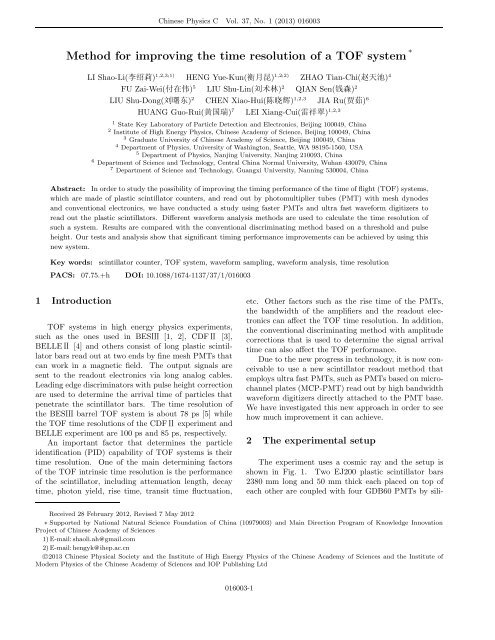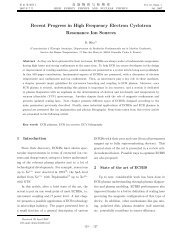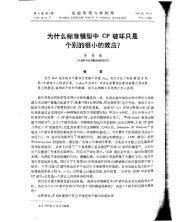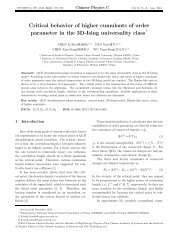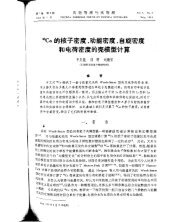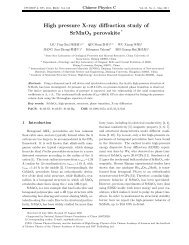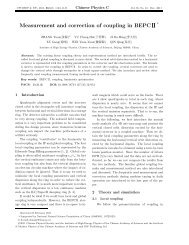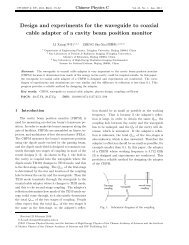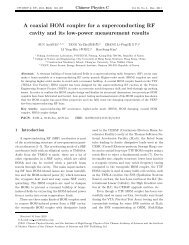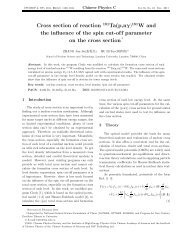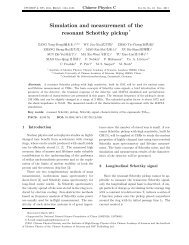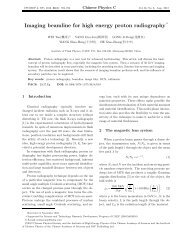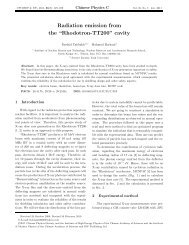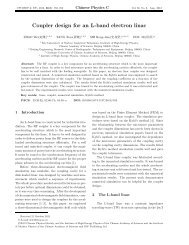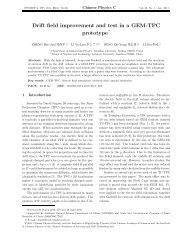Method for improving the time resolution of a TOF system*
Method for improving the time resolution of a TOF system*
Method for improving the time resolution of a TOF system*
- No tags were found...
You also want an ePaper? Increase the reach of your titles
YUMPU automatically turns print PDFs into web optimized ePapers that Google loves.
Chinese Physics C Vol. 37, No. 1 (2013) 016003Fig. 4. Diagram <strong>of</strong> calculating <strong>the</strong> start <strong>time</strong>, we only show part <strong>of</strong> <strong>the</strong> cosmic ray signal wave<strong>for</strong>m so you can havea clear view: (a) <strong>the</strong> first method: simulating <strong>the</strong> traditional discriminating method; (b) <strong>the</strong> second method: linearfitting; (c) <strong>the</strong> third method: Landau fitting; and (d) <strong>the</strong> fourth method: fourth order polynomial fitting.Considering more points are used, <strong>the</strong> <strong>time</strong> value shouldbe more accurate than <strong>the</strong> first method.The third method (Fig. 4(c)) also uses data pointsinside an amplitude interval. The difference from <strong>the</strong>second method is that <strong>the</strong> interval is from 0% to 50% <strong>of</strong><strong>the</strong> signal height and <strong>the</strong> model used is <strong>the</strong> Landau distribution.In Fig. 4(c), <strong>the</strong> Landau curve is drawn, whichcovers this interval and <strong>the</strong> <strong>time</strong> value can be obtainedbased on <strong>the</strong> Landau function and threshold value.The fourth method (Fig. 4(d)) uses data points insidean amplitude interval from 0% to 50% <strong>of</strong> <strong>the</strong> signalheight which is <strong>the</strong> same interval as we used in <strong>the</strong> thirdmethod. We try to use a polynomial curve fitting <strong>the</strong>data points. Here we fit <strong>the</strong> data points with a fourthorder polynomial curve to obtain <strong>the</strong> discriminating <strong>time</strong>value.The <strong>time</strong> interval chosen in <strong>Method</strong> two is 20% to60% because <strong>the</strong> o<strong>the</strong>r part <strong>of</strong> <strong>the</strong> rising edge curves alot which does not fit <strong>the</strong> linear model. Since <strong>the</strong> morepoints you use in <strong>the</strong> third method <strong>the</strong> more fitting errorsyou will get [7], we choose <strong>the</strong> <strong>time</strong> interval from0% to 50% in <strong>Method</strong> three. This interval guaranteesthat enough wave<strong>for</strong>m in<strong>for</strong>mation will be used while<strong>the</strong> fitting error will not be too large. The fitting intervalchosen <strong>for</strong> method four is <strong>the</strong> same as with methodthree so we can compare results from <strong>the</strong>se two differentfitting methods.The first method which calculates <strong>the</strong> <strong>time</strong> value onlyuses two points while <strong>the</strong> o<strong>the</strong>r three methods use moredata points from <strong>the</strong> wave<strong>for</strong>m. We expect to see that<strong>the</strong> <strong>time</strong> <strong>resolution</strong> will be better if more wave<strong>for</strong>m in<strong>for</strong>mationis used. Fig. 4 (b), (c) and (d) indicates that<strong>the</strong> Landau curve and polynomial curve fit <strong>the</strong> wave<strong>for</strong>mbetter than <strong>the</strong> linear curve. This means <strong>the</strong> <strong>time</strong> <strong>resolution</strong>given from Landau and polynomial fitting shouldbe better than <strong>the</strong> o<strong>the</strong>r two.Although <strong>the</strong> choice <strong>of</strong> fitting <strong>time</strong> interval can influence<strong>the</strong> result, <strong>the</strong> third and fourth methods which use<strong>the</strong> Landau and fourth order polynomial fitting give better<strong>time</strong> <strong>resolution</strong> than <strong>the</strong> o<strong>the</strong>r two methods. As westudied, changes in <strong>the</strong> <strong>time</strong> interval (like plus or minus10% <strong>of</strong> <strong>the</strong> signal amplitude) will not change <strong>the</strong> best<strong>time</strong> <strong>resolution</strong> value much, but <strong>time</strong> <strong>resolution</strong> valuescalculated using a too small (like 5% or 10% <strong>of</strong> <strong>the</strong> signalamplitude) or big (like 40% <strong>of</strong> <strong>the</strong> signal amplitude)threshold value will vary a lot.3.4 Time <strong>resolution</strong> <strong>of</strong> <strong>the</strong> systemThere are four channels <strong>of</strong> signals from PMT GDB60and <strong>the</strong> discriminating <strong>time</strong> values are noted as T 1 , T 2 ,T 3 and T 4 . The <strong>time</strong> <strong>resolution</strong> <strong>of</strong> <strong>the</strong> system can becalculated based on this:T = (T 1+T 2 )−(T 3 +T 4 ), (5)4(T 1 +T 2 )−(T 3 +T 4 ) can reduce <strong>the</strong> hitting position variation<strong>of</strong> <strong>the</strong> cosmic ray and <strong>the</strong> uncertainty <strong>of</strong> start <strong>time</strong><strong>of</strong> <strong>the</strong> system.016003-4
Chinese Physics C Vol. 37, No. 1 (2013) 016003Fig. 5. Time <strong>resolution</strong>s from four different methods <strong>for</strong> a threshold <strong>of</strong> 15% amplitude. All <strong>the</strong> events are takenfrom <strong>the</strong> same PMT. (a) <strong>the</strong> first method; (b) <strong>the</strong> second method; (c) <strong>the</strong> third method; (d) <strong>the</strong> fourth method.Figure 5 shows <strong>the</strong> examples <strong>of</strong> spectra <strong>of</strong> <strong>time</strong> Tcalculated from four different methods fitted by normaldistributions and <strong>the</strong> threshold value was assumed to be15% <strong>of</strong> <strong>the</strong> signal amplitude. The <strong>time</strong> <strong>resolution</strong> valuescalculated from <strong>the</strong> first, second, third and fourth methodsare 69.8 ps, 83.6 ps, 65.43 and 65.41 ps separately.The <strong>time</strong> <strong>resolution</strong> given from Fig. 5 is <strong>the</strong> <strong>time</strong> <strong>resolution</strong><strong>of</strong> one end. Our setup uses a two end readoutsystem, so <strong>the</strong> <strong>time</strong> <strong>resolution</strong> <strong>of</strong> one <strong>TOF</strong> counter hereis <strong>the</strong> value divided by √ 2. Fig. 6 shows <strong>the</strong> threshold<strong>of</strong> different percentage vs. <strong>time</strong> <strong>resolution</strong>. Please notethat <strong>the</strong> <strong>time</strong> <strong>resolution</strong> values here have already beendivided by √ 2. The best <strong>time</strong> <strong>resolution</strong> <strong>of</strong> <strong>TOF</strong> readout at two ends is 46.3 ps using a Landau or polynomialfitting when <strong>the</strong> threshold is 15% <strong>of</strong> <strong>the</strong> signal amplitude.From Fig. 6, we can see that <strong>the</strong> Landau and polynomialfitting method give <strong>the</strong> best result while polynomialfitting is simpler. The linear fitting method is <strong>the</strong> worstone <strong>for</strong> <strong>the</strong> reasonable actual threshold value. In addition,<strong>the</strong> Landau curve fits <strong>the</strong> wave<strong>for</strong>m better at <strong>the</strong>starting part and worse at <strong>the</strong> crest part. The low thresholdarea corresponds to <strong>the</strong> starting area <strong>of</strong> <strong>the</strong> rise edgewhere <strong>the</strong> wave<strong>for</strong>m curves a lot, that’s why <strong>the</strong> linearfitting become worse.Fig. 6. Threshold vs. <strong>time</strong> <strong>resolution</strong> with errorbars. TFM refers to <strong>the</strong> traditional fittingmethod. PFM refers to <strong>the</strong> linear fittingmethod. LFM refers to <strong>the</strong> Landau fittingmethod. POL4 refers to <strong>the</strong> fourth order polynomialfitting method.016003-5
Chinese Physics C Vol. 37, No. 1 (2013) 0160034 Conclusions and discussionsThe ultra fast PMT and wave<strong>for</strong>m sampling techniqueused in our experiment significantly improve <strong>the</strong><strong>time</strong> <strong>resolution</strong> <strong>of</strong> <strong>the</strong> <strong>TOF</strong> system since detailed in<strong>for</strong>mationabout <strong>the</strong> signal shapes can be obtained from <strong>the</strong>wave<strong>for</strong>ms and used in <strong>the</strong> analysis.We have shown that among <strong>the</strong> four methods studied,<strong>the</strong> wave<strong>for</strong>m analysis based on Landau and fourthorder polynomial curves are better than <strong>the</strong> traditionaldiscrimination method which give <strong>the</strong> best <strong>time</strong> <strong>resolution</strong><strong>of</strong> 46.3 ps, this is significantly better than <strong>the</strong> per<strong>for</strong>mance<strong>of</strong> current <strong>TOF</strong> systems. This is due to <strong>the</strong> factthat more accurate in<strong>for</strong>mation can be obtained by fitting<strong>the</strong> rising edges <strong>of</strong> <strong>the</strong> recorded wave<strong>for</strong>ms, which ismuch better than simply using a linear function extrapolation.Results from <strong>the</strong> first method are better thanwe have expected, mainly because <strong>the</strong> wave<strong>for</strong>m in<strong>for</strong>mationis still used here to calculate <strong>the</strong> amplitude and<strong>the</strong> start <strong>time</strong>. While <strong>the</strong> Landau, polynomial and linearfitting method rely on <strong>the</strong> choice <strong>of</strong> fitting <strong>time</strong> interval,<strong>the</strong> traditional fitting method only uses two recordedpoints.Technologies <strong>of</strong> a fast PMT and a high sampling ratewave<strong>for</strong>m digitizer are developing rapidly [8] and wave<strong>for</strong>mdigitizers with 10 Gs/s sampling rate or higher maybecome available in <strong>the</strong> near future. They can be consideredto implement <strong>the</strong> techniques described in thispaper in <strong>the</strong> future <strong>TOF</strong> systems. The oscilloscope usedto record wave<strong>for</strong>ms in our test would be replaced byintegrated high rate wave<strong>for</strong>m digitizers that are compactand inexpensive. The long analog cables that limitsignal bandwidth in a conventional <strong>TOF</strong> system can beeliminated.References1 BES collaboration. Nucl. Instrum. <strong>Method</strong>s A, 2009, 598(1):72 BES Design Report, http://bes.ihep.ac.cn3 Paus Ch, Grozis C, Kephart R et al. Nucl. Instrum. <strong>Method</strong>sA, 2001, 461(1–3): 5794 Kichimi H, Yoshimura Y, Browder T et al. Nucl. Instrum.<strong>Method</strong>s A, 2000, 453(1–2): 3155 HENG Yue-Kun. The Two Scintillator Detectors on BES.In: IEEE Nuclear Science Symposium and Medical ImagingConference. USA, NSS/MIC, 2007, (1): 536 WU Jing-Jie, HENG Yue-Kun, SUN Zhi-Jia et al. CPC (HEP& NP), 2008, 32(3): 1867 LIU Ji-Guo. Measurement Error Analysis and Time Correction<strong>Method</strong> <strong>for</strong> Scintillator <strong>TOF</strong> Detector (Ph. D. Thesis). Hefei:University <strong>of</strong> Science and Technology <strong>of</strong> China, 20048 CAEN VX1761 Digitizer, http://www.caen.it/csite/CaenProd.jsp?showLicence=false&parent=1&idmod=673016003-6


